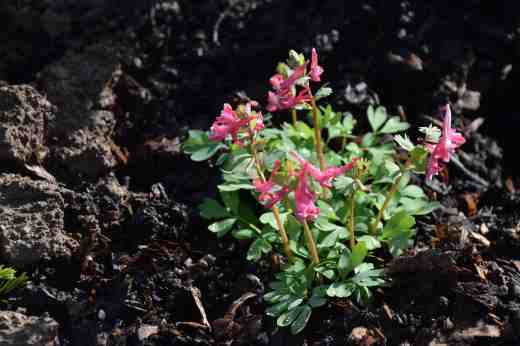Corydalis solida: an early gem
I don’t remember quite when I first met Corydalis solida, but we have been friends for many years.
It is an early-spring blooming tuber, one of the legion corydalis that range from weeds to alpine treasures that require careful nurturing. The most familiar is probably Corydalis lutea with ferny leaves and an endless stream of delicate, yellow flowers. There is a less common, white form though I can’t honestly say that I like it more. This particular plant is native and seeds itself in walls and paving and can be weedy. But it is so delicate in appearance and has such lovely leaves and flowers that it is easily forgiven its excessive boisterousness.
Like all, it is in the Fumariaceae, a family closely related to the poppies, though, with their intricate, spurred blooms, it is hard to see any resemblance. The stems and petioles are characteristically brittle and glassy.
Some corydalis are herbaceous while others tuberous. The most exciting are the hybrids involving the Chinese C. flexuosa which have brought true blue corydalis into the general garden. Before these the blues, including the legendary C. cashmeriana, were beyond the skill of most. It is unfortunate that one of the best, with gorgeous blue, fragrant flowers, is named ‘Tory MP’. It won’t find a place in my garden. Luckily there are plenty of others such as ‘Heavenly Blue’ and ‘Craighton Blue’. They all have a habit of going dormant in the heat of summer, which can be a bit alarming. They come up and bloom in spring and then die off, to reappear and put in a repeat performance, in early autumn.
But back to Corydalis solida, which is native to Northern Europe and central Asia. The typical species is a slightly dull, dirty pink with a hint of mauve about it. It is unkind to be critical of this though since the flowers are abundant and look great against the ferny, smoky green leaves. It starts to flower almost as soon as it emerges from the ground and gets better as the leaves fluff out so that, by now, it is a thing of beauty. And then, in early May, it melts away in the heat and will not be seen again for another nine months.
This brief appearance may put you off but apart from being a lovely little thing, that is tough enough to grow in shade under shrubs and even in weak grass in shade, it is especially valuable because it provides colours missing in the usual parade of spring bulbs that are primarily blue, white and yellow. Add the fact that it is easy to grow and I think it has huge garden merit. It is not too fussy about soil as long as it is not too extreme – extra organic matter is a bonus of course as it is primarily a woodland plant.
Specialists are working hard breeding lots of novel colours and these slowly work their way into catalogues. The most famed of established kinds is ‘GP Baker’ but I find its coral-red shade so uncompromising that I am never sure how to use it. I guess I should relax and just enjoy its brightness. ‘Beth Evans’ is far more lovely in the garden – a bright pink. I moved some this spring, as they were emerging. The original tubers I had planted had split into many and they seem to have settled in well.
Last autumn I planted dormant tubers of one called ‘Purple Bird’ which I planted under a Prunus incisa ‘Paean’ in pink. It was recently introduced by Jan Huisman from Heemstede in the Netherlands. It is described as an excellent, strong growing, deep purple selection from a cross of deep red Corydalis solida Zwanenburg and a purple Corydalis solida. I am pleased that flowers have a rich, purple, ‘grapey’ colour that is very attractive. I like it and I think I may mix it with some silver-leaved cyclamen. Note that both my photos are of young plants and they look much more impressive after a year or two. ‘Purple Bird’ would also look good with ‘Beth Evans’ but I am a bit worried that the two would hybridise and I will end up with a mix of colours. But then would that be so bad?
Geoff’s rating
9/10
Garden rating
8/10


Very enjoyable little plants.